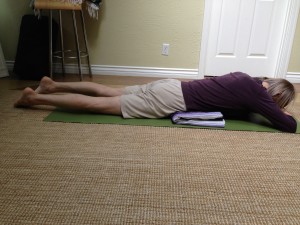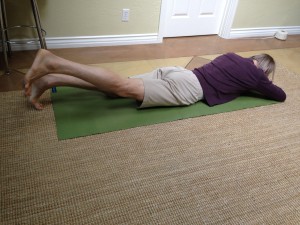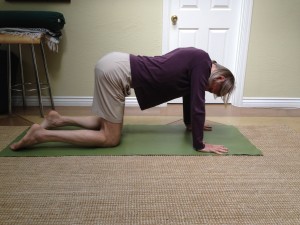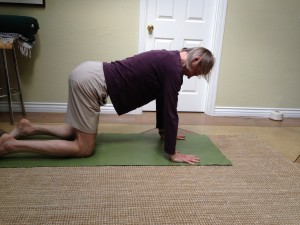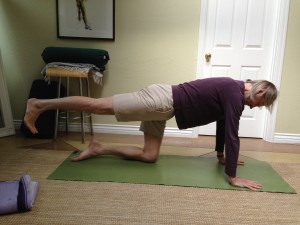What is a Hip Opener? (part 2)
A hip opener is a posture meant to increase a particular range of motion or multiple ranges of motion in the hip joint. The most important aspect of such a posture is that the hip be targeted and that the force applied to the hip to create the opening not be diverted into the lower back or the knee. Hip extension is one ROM of the hip that often gets neglected because of the ease with which many of us use the joints in the lower spine to do motions that would otherwise be done from the hip. Working on hip extension is therefore extrememly hepful and important not only for health and function of the hips but also that of the lower back.
Improving hip extension will help prepare the body for backbends as well as help to support healthy gait mechanics. The simplest way to work on hip extension is from a prone position. Lie face down on the floor and find a comfortable position for you head, perhaps resting your forehead on a blanket or on your forearm. Check and see if the pubic bone and the frontal most aspect of the 2 ilium (the A.S.I.S. or anterior superior iliac spine) are resting on the floor. If the pubic bone doesn’t easily rest on the floor, try placing a folded blanket just above it on the 2 A.S.I.S.. The idea is to tilt the pelvis back a bit to bring the pubic bone in contact with the floor (see figure 1).
If the 2 A.S.I.S. are not able to rest on the floor when the pubic bone is in contact with the floor the blanket support will offer something for the 2 A.S.I.S. to rest against. Whatever the case, getting the pubic bone in contact with the floor is crucial. Once you have it down, then lift your right leg off the floor while keeping the knee straight. Make sure the pubic bone stays in contact with the floor. This is hip extension (see figure 2).
Hold the position for a few seconds, making sure that the pelvis doesn’t roll to one side when the leg is lifted. Lower the right leg and try it with the left leg. If your feel pain in your back and/or on either side of the sacrum (on the back of the pelvis) when doing hip extension as described above, try pushing the pubic bone down into the floor with moderate force and then lifting the leg again. If this doesn’t at least reduce if not resolve the pain then suspend working on hip extension this way and move on to the next option (see figures 3-5 below). If you can lift each leg with your pubic bone remaining in contact with the floor and without pain in your back, then try doing this in front of a mirror so you can see how much hip extension you actually have. How high does the leg lift before your pubic bone starts to lift as well? 6 inches? 10 inches? 1 inch? See what you’ve got currently so you have a baseline from with to assess progress.
Repeat this method of extending the hip 3-4 times on each leg, feeling the muscles in the back of the hip and thigh working to lift the leg. Continue to keep the knee straight and the pubic bone in contact with the floor. If your low back starts to hurt as you’re holding the leg up, decrease the height of the leg until the pain goes away and continue. As long as you’re not experiencing back pain, begin increasing the time of hold to 20-30 seconds. Then rest a few breaths and come up.
If your back hurts when you try the above, no matter how high or low you lift the leg, then try the following instead. Come to your hands and knees with your fingers and thumbs spread, your wrists directly over your hands and your knees directly under your hips. If you knee caps are sensitive to pressure, have your knees on a blanket for more cushion. Allow the pelvis to rotate forward and your back to arch as much as is comfortable. Try not to actively arch the back but let the arch happen by relaxing the abdomen toward the floor (see figure 3). Then, using your abdominal muscles, lift your lower front ribs up away from the floor and pull them in toward the spine until you feel the middle of your spine round out slightly. Be careful not to tuck your pelvis when you do this.
You can use a mirror to get feedback. You should see a clearly concave lumbar spine and a clearly convex thoracic spine. If upon looking at your image in the mirror you find it’s hard to tell where the lumbar ends and the thoracic begins, continue to lift the lower ribs up and in toward the spine until you can begin to see the junction of lumbar and thoracic. Then lift up the portion of the thoracic spine in between the shoulder blades by pushing your palms into the floor with your arms held straight. Try to feel the rhomboids, the muscles that connect your shoulder blades to your spine, becoming longer and more active(figure 4).
Now push down through your left knee until your left hip engages and your right knee begins to lift off the floor. Be conscious of lifting the right knee up by using the left hip and not by using the muscles in your lower back. Once the right knee is lifted, stretch the leg out behind you until the knee is straight. Keeping the left hip active and the right knee straight, gradually lift your right thigh toward the ceiling (figure 5). Avoid arching your back and dropping your lower ribs toward the floor. Also be sure to keep the upper thoracic spine lifted and the shoulder blades wide. Hold the leg up for 10-15 seconds, then lower the leg and repeat on the opposite leg. Repeat each side 3 times.
This is also hip extension and this version will typically work for everyone and is particularly helpful for those who’s hip extension is limited. The exception is anyone who cannot bear weight on their hands this way. If this includes you then seek help from an experienced teacher to work on your hip extension. There are many postures that can be used to increase hip extension in addition to the above. In the part 3 I will discuss another of my favorites!

